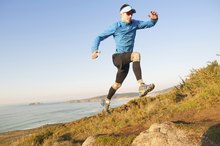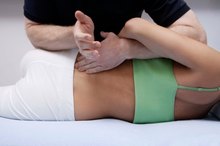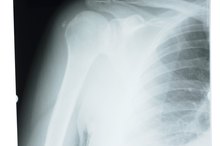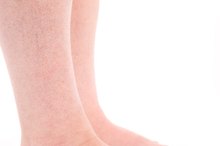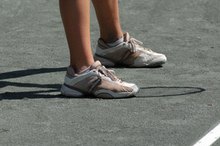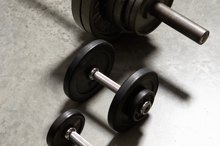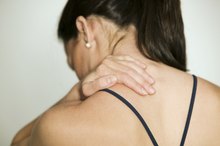Pain in the Left Arm After Exercise
Pain in your left arm during exercise may be due to local issues or problems that involve other areas of the body.This pain can range in severity from a minor inconvenience to a life-threatening condition.
Ligament
Pain during an exercise in your left arm may be a sign of ligament damage in your wrist, elbow or shoulder. Stretching of a ligament will cause pain during movement and swelling may also be present. A physician will diagnose this problem with a physical examination, x-ray and MRI. The treatment for ligament damage is immobilization, surgery or a combination of both.
- Pain during an exercise in your left arm may be a sign of ligament damage in your wrist, elbow or shoulder.
- The treatment for ligament damage is immobilization, surgery or a combination of both.
Muscle
Running & Collarbone Pain
Learn More
Damage to the muscle fibers may also be the cause of pain in your left arm during exercise. Muscle fiber damage ranges from strains to tears. The symptoms of a muscle injury are pain, swelling and the loss of mobility in the affected area. Muscle strains are diagnosed by using MRI, physical examination and computerized tomography. A muscle injury is treated using rest and surgery.
- Damage to the muscle fibers may also be the cause of pain in your left arm during exercise.
Nerve
Pain in the left arm may be a result of a pinched nerve. This type of problem may manifest itself through pain in the area of the pinched nerve. The pain may also travel down the trajectory of the nerve. Muscle weakness and numbness may also occur as a result of a pinched nerve. MRI and electromyography are used to diagnose pinched nerves in your left arm. A pinched nerve is treated using corticosteroid injections, analgesics, physical therapy and if necessary, surgery.
- Pain in the left arm may be a result of a pinched nerve.
- This type of problem may manifest itself through pain in the area of the pinched nerve.
Heart Attack
Treatment for a Pinched Nerve in the Hip
Learn More
Pain in your left arm during exercise may be a sign of a heart attack. The rise in blood pressure while exercising may bring about a heart attack in at-risk individuals. The pain in your left arm during a heart attack may radiate down your back and to your jaw, as well. Sweating, shortness of breath, chest pains and vomiting are other symptoms that may appear during a heart attack. A heart attack is diagnosed using an electrocardiogram, an echocardiogram, blood tests, a stress tests, angiogram, MRI,computerized tomography and a chest x-ray. Heart attacks may be treated using medications such as blood thinners, nitroglycerin or beta blockers. In some cases, surgery is required to treat a heart attack victim.
- Pain in your left arm during exercise may be a sign of a heart attack.
Related Articles
References
- MayoClinic.com:Health: Heart Attack
- MayoClinic.com:Health:Pinched Nerve
- "Harrison's Principles of Internal Medicine (16th edition)"; Lawrence Madoff et al; 2005
- "Preventive and Social Medicine"; K. Park, J. E. Park; 1995
- Hochman MG, Zilberfarb JL. Nerves in a pinch: imaging of nerve compression syndromes. Radiol Clin North Am. 2004;42(1):221-45. doi:10.1016/S0033-8389(03)00162-3
- NIH National Institute of Neurological Disorders and Stroke. Pinched nerve information page. Updated March 27, 2019.
- AdventHealth Medical Group. Cauda equina syndrome.
- AAOS OrthoInfo. Cervical radiculopathy (pinched nerve). Updated June 2015.
- Dimitrova A, Murchison C, Oken B. Acupuncture for the treatment of peripheral neuropathy: A systematic review and meta-analysis. J Altern Complement Med. 2017;23(3):164-179. doi:10.1089/acm.2016.0155
- Conger A, Cushman DM, Speckman RA, Burnham T, Teramoto M, McCormick ZL. The Effectiveness of Fluoroscopically Guided Cervical Transforaminal Epidural Steroid Injection for the Treatment of Radicular Pain; a Systematic Review and Meta-analysis. Pain Med. 2019 Jun 10. pii: pnz127. doi:10.1093/pm/pnz127 [Epub ahead of print]
- Keating L, Treanor C, Sugrue J, Meldrum D, Bolger C, Doody C. A randomised controlled trial of multimodal physiotherapy versus advice for recent onset, painful cervical radiculopathy - the PACeR trial protocol. BMC Musculoskelet Disord. 2019 Jun 1;20(1):265. doi:10.1186/s12891-019-2639-4
Writer Bio
Dr. Robert Petros has been working at the Yerevan State Medical University Department of Epidemiology and Infectious Diseases since 2009. He has had experience with thousands of patients and done a considerable amount of work in epidemic prevention on the government level.
